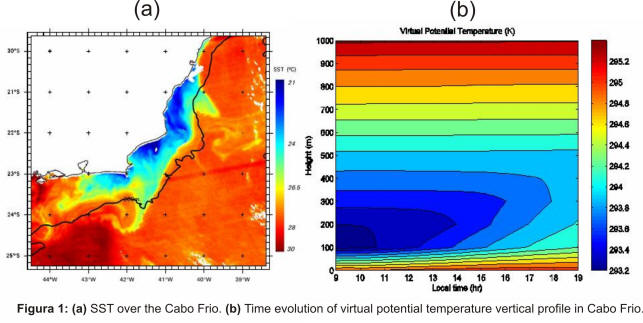SOLAS - BRAZIL
Surface Ocean Lower Atmosphere Study Brazil
Study of Atmospheric Boundary Layer in the Region of Brasil-Malvinas Confluence
Marcelo Dourado
Centre for Ocean Studies
Federal University of Paraná, Pontal do Sul, PR,
Brazil
(dourado@ufpr.br)
Turbulence in the oceanic (OBL) and atmospheric (ABL) boundary layer plays a vital role in the interaction between ocean and atmosphere, by controlling exchanges of heat, momentum and mass at the sea surface. These air-sea exchanges have great importance on determining the weather and the climate.
Besides, important bio-geochemical cycles are strongly controlled by air-sea interactions. For instance, the generation of planktonic biomass for carbon setting in the euphotic layers of the superficial ocean constitutes the first link in the oceanic food chain. The atmospheric carbon dioxide removal is also important as compensation to the increasing release of anthropogenic atmospheric CO2 by fossil fuel burning (Kantha, 2004).
The assessment of air-sea interactions is particularly relevant over the coupled oceanic regions. In Brazil there are two important coupled oceanic regions: Cabo Frio and Malvinas.
In the Cabo Frio region (23oS, 42oW), the upwelling has great influence on the primary productivity and in local climate (Dourado and Oliveira, 2008).The Brazil-Malvinas confluence (34oS-46oS and 43oW-60oW) is one of the most energetic regions of the world and sink of the CO2. The sea surface temperature differences between the Brazil warm) and the Malvinas (cold) waters intensify the sensible and latent heat fluxes during the passage of cold fronts moving from the continent towards the sea. This release of latent heat flux is important to the cyclogenesis energy budget in this region (Pezzi et al., 2005).
Boundary layer numerical models coupling the ocean and the atmosphere can be a useful tool to study coupled regions, like the ones discussed above, because they are developed to evaluate small scale processes in the air-sea interface.
The coupling between the ABL and OBL has to be understood as a problem of fluid dynamics, where the main difference is the fluid’s density. Basic dynamic equations, in which the density is one of the variables, can be applied to both sides of the interface, and in some cases the similarity of the physical processes in the two media, can be notable. For instance, a vertical profile of normalized dissipation rate of the turbulent kinetic energy in the OBL and ABL are very similar when turbulence is kept by thermal convection (Smith et al., 1996).
Difficulties in obtaining in situ measurements lead us to the use of numerical modeling technique to study the interactions between the ocean and the atmosphere. The main goal of this investigation is to study the role played by turbulence on the air-sea interaction over these two regions of the Brazilian shore using numerical models.
The atmospheric boundary layer model used in the present investigation is a second-order closure model based in Mellor and Yamada parameterization. It was coupled to a bulk oceanic boundary layer model and used to investigate the impact of the atmosphere-ocean contrast on the intensity of vertical evolution of ABL over the Cabo Frio area. The numerical simulations indicated that the vertical extent of the ABL increases about 360 m (200 m to 560 m) – during a period of 10 hours in the Cabo Frio region during the passage of a cold front disrupting of the upwelling regime (figure 1).
The next step will be to replace the bulk oceanic boundary layer model by a diffusion oceanic boundary layer model. This project is of relevance to the SOLAS-FOCUS 2 program and has been sponsored by the CNPq (Grant No. 475708/2007-5).
REFERENCES:
Dourado M.S. and Oliveira A.P., 2008: A numerical investigation of the atmosphere-ocean thermal contrast on the PBL short-term variation over the coastal upwelling region of Cabo Frio. Atmósfera (México), 21, 13-34.
Kantha L.H., 2004: A General Ecosystem Model for Applications to Primary Productivity and Carbon Cycle Studies in the Global Oceans. Ocean Modelling, 6, 285-334.
PEZZI L.P., SOUZA R.B., DOURADO M.S., MATA M.M., GARCIA C.A.E., 2005: Ocean-Atmosphere In Situ Observations at the Brazil-Malvinas Confluence Region. Geophysical Research Letters, v. 32, p. 34-35.
Smith S.D., Fairall, C.W., Geernaert G.L., and Hasse L., 1996. Air-Sea Fluxes: 25 Years of Progress. Bound.-Layer Meteor., 78, 247-290.
PUBLICATIONS
Dourado M.S. and Oliveira A.P., 2008: A numerical investigation of the atmosphere-ocean thermal contrast on the PBL short-term variation over the coastal upwelling region of Cabo Frio. Atmósfera (México), 21, 13-34.
Vaghetti N.N. and Dourado M.S., 2008: Resposta do Oceano Superficial à Passagem de um Sistema Frontal na Região da Confluência Brasil-Malvinas. In: III Congresso Brasileiro de Oceanografia, Fortaleza. III Congresso Brasileiro de Oceanografia.
Dourado M.S., Souza R.B., Garcia C.A.E, Mata M.M., Sato O., 2008: Estudo dos fluxos turbulentos na região da confluência brasil-malvinas. Anais do XV Congresso Brasileiro de Meteorologia, São Paulo, SP.